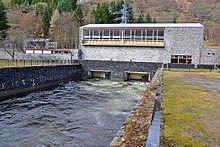Energy 101
Energy 101
Learn how hydropower captures the kinetic energy of flowing water and turns it into electricity for our homes and businesses.
Learn how hydropower captures the kinetic energy of flowing water and turns it into electricity for our homes and businesses.
Although the high-water mark for the Green New Deal may have passed, it pushed climate and energy to the forefront of the news cycle. It’s also prompted Republicans to counter with proposals of their own — including Senator Lamar Alexander’s new Manhattan Project for Clean Energy and Representative Matt Gaetz’s Green Real Deal. With these discussions, it’s important to note the realistic role that hydropower can play. And because this is Waterpower Week, many of these solutions will be showcased in Washington.
The past year has been great for hydropower. Most notably, America’s Water Infrastructure Act of 2018 (AWIA) was signed into law by President Trump last October after passing in the Senate nearly unanimously, 99-1, and passing in the House on a voice vote. There should be no remaining doubt that developing America’s renewable energy sector has become a mainstream priority widely embraced by members of both political parties.
Among the routine authorization points, there are several provisions in the new water act that could help reinvigorate hydropower development — and help reduce greenhouse gas emissions — in 2019 and beyond.
Only 3 percent of our nation’s 80,000 aging dams generate electricity. Expedited licensing process for installing hydropower generation at existing dams that don’t produce electricity could be a major win for revitalizing some of our nation’s aging infrastructure. While many of these dams may no longer be needed or should be taken down to restore waterways, many dams can be retrofitted for hydropower to provide affordable electricity and create much-needed jobs across rural America.
Additionally, the legislation will enable closed-loop pumped storage hydropower which can make sure supply meets demand at the right time and provides an especially important complement for other renewables like solar and wind.
The law will also help ramp up hydropower development in our existing water infrastructure. For example, there are 1.2 million miles of water supply mains in our nation, and the amount of hydropower that could be harvested just from these supply mains alone is staggering. With the new law, it will be easier for private companies and water utilities to get a chance at harvesting that power.
In many ways, the law helps us get back to the basics. Hydropower is one of the largest and oldest sources for U.S. renewable energy, and today it generates energy for over 30 million homes across the country. Washington, Idaho, Oregon and Vermont get over 50 percent from hydropower while South Dakota, Montana, Alaska and Maine get over 25 percent.
Although hydropower is already a big contributor to America’s grid, there is still untapped potential. New analysis from the U.S. Department of Energy’s Hydropower Vision Report revealed that hydropower can grow almost 50 gigawatts from its current 101 gigawatts capacity in the next 30 years. This analysis supports hydropower’s ability to transform modern energy markets, and with energy policy that removes market barriers, our private sector will undoubtedly drive the next wave of new hydropower development.
Hydropower also means American-made power. Building out hydropower will open up domestic energy jobs for our workers. The industry already supports at least 140,000 jobs, and the measures included in the 2018 AWIA should jumpstart the hydropower sector to new heights.
The reforms will reduce the onerous licensing and relicensing processes that were once required for non-federal hydropower facilities, effectively opening up the market for new business.
While Green New Deal is not the answer to our energy management problems, the debate will soon start for the Green Real Deal — which appears to support further modernization for hydropower regulations. The renewed emphasis on clean, domestic energy could not come at a better time. Oil markets are prone to price changes and as political instability continues to ripple over the world’s nations, securing energy sources that are reliable and replenishable should be a prime concern for our elected leaders.
The plan for climate change that carries the day should attract strong bipartisan support, like the water act. Further emphasis on hydropower will be welcome as a realistic part of the solution that’s ready to be tapped.

Use of modular precast elements to build hydropower facilities and dams can reduce the cost of this work by half, says FDE Hydro . The company says physical civil construction is the largest single component of new hydropower development cost, from 40% to 90% of total capital cost depending on the project size.
To address this situation, FDE Hydro has developed a technology, called the French Dam, that is based on modular components manufactured off-site in a controlled environment. These modules cab be secured to the riverbed using underpinning and interconnected with adjacent modules to complete a dam (more).
Modular and Integrated Components
Potential hydropower cost reductions and performance enhancements can be realized through common equipment configurations. …..
Figure ES-10 illustrates an example standardized approach under which a suite of modular components for foundation, generation, and stream passage may be considered and fit together to meet site-specific parameters as well as environmental and power generation objectives. (Page 19, Executive Summary, Hydropower VISION)